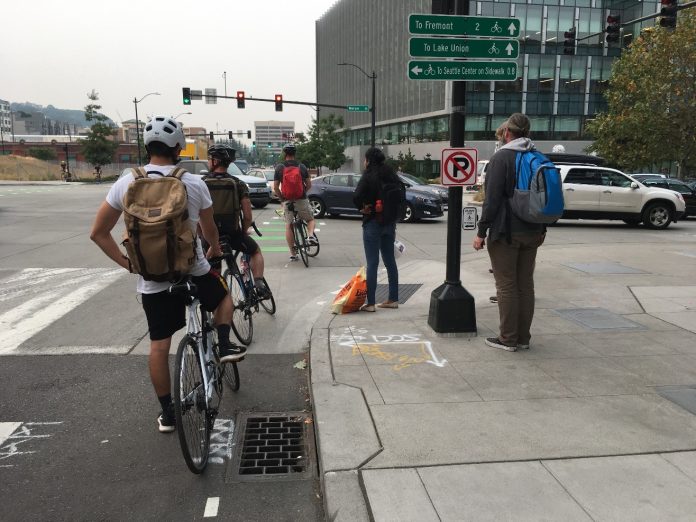
Washington State’s transportation infrastructure has been described as “on a glidepath to failure.” Our road conditions are consistently ranked among the worst in the nation. Traffic jams abound. Major bridges are either out of commission or face deferred maintenance. The reason for this sorry state is that the cost of maintaining our roads has consistently outpaced the gas tax revenues that are allocated for this task. Those revenues have steadily declined, as the cost of maintaining our roads has risen.
Meanwhile, many of our residents lack transit options, and this creates barriers to accessing opportunity. Less than 4% of our current state transportation budget supports multimodal investments, such as transit, biking, walking, and rolling connections.
Our legislators are developing plans to fix this mess. Senate Transportation Committee Chair Steve Hobbs released his Forward Washington Package; Vice Chair Rebecca Saldaña released her Evergreen Plan; and over in the House, Transportation Chair Jake Fey released a package even more weighted toward transit and climate action. These proposals lay out major transportation investments over the next 16 years and present quite different visions of the future of our transportation infrastructure.
All the plans increase the gas tax–the House plan most of all. All the plans assume that we need to allocate new revenue sources to transportation. They all assume that the state will adopt one of the two carbon pricing plans being considered this year. Other taxes could include an air quality surcharge tax on the sale of cars or a road usage charge. Budget negotiations remain active until the session ends, and this year there are many options on the table.
All the plans fund major bridge repairs and substantial road maintenance on our existing road system. But beyond that, they reflect quite different visions of our transportation future. The House plan and Saldaña’s plan are more ambitious and transformative, and include a significantly increased investment in transit, as well as pedestrian and bicycle infrastructure. Significantly, Saldaña’s and the House plan include only a few new roadway or highway widening projects. The Senate plan continues with the status quo approach to responding to traffic congestion problems around the state by including substantial money for new road construction and highway lane expansion projects.
Benefits of a people-first, car-lite approach
Any day now, the House and Senate packages will be released as bills, and our legislature will start to negotiate in earnest about the future of our transportation system. Given the crises we face, the transformational House approach makes most sense. Here are seven key reasons:
- We can’t solve congestion by building more roads and more lanes. Despite myths to the contrary, expanding road capacity inevitably invites the return of traffic jams. Traffic engineers call this “induced demand” or the “fundamental law of road congestion“–the more roads and lanes we build, the more cars fill them up with congestion. Highway expansion is the history of traffic jams repeating itself.
- The Senate approach is unaffordable for our state and for many of our families. Building more roads and lanes will make maintaining our transportation system even more costly at a time when we can’t afford to maintain our current roads. And for many families who are struggling economically, especially during the pandemic recession, the cost of car dependency has become increasingly burdensome. According to the American Public Transportation Association, “A household can save nearly $10,000 (per year) by taking public transportation and living with one less car.”
- Demand for better multimodal transportation has never been greater. Twenty-five percent of Washingtonians do not have a driver’s license–people with disabilities, minors, and others who can’t drive or afford a car, all face substantial mobility challenges with our current system. As the Washington State Department of Transportation (WSDOT) notes, “In a transportation system primarily built for high-speed auto travel, counts of people walking and biking will not indicate true levels of need.” Folks without a driver’s license are essentially trapped in their homes if local roads are dangerous or public transit is inaccessible. And those of us with drivers licenses would also bike and walk more if it were safer. A WSDOT report notes that “about half (47%) of all trips taken in the U.S. are less than three miles long and could be completed in a 15-20 minute bike ride, yet the vast majority of short trips are made by automobile.”
- We are healthier when we build infrastructure for walking and biking. As the draft WSDOT Active Transportation Plan states: “In essence, transportation policy is health policy. A study of walkability and health outcomes in King County found that walkable neighborhoods result in more walking, improved health, and lower emission of pollutants.” The higher incidence of Covid infection in more polluted communities, which are also typically lower-income and BIPOC communities, illustrates how transportation policy can also be unjust health policy.
- We save lives when we invest in walking and biking. Washington State has long struggled to make progress on its Target Zero goal of zero deaths from traffic. As the Active Transportation Plan states, “Past efforts have not succeeded in eliminating or even reducing the annual number of traffic deaths and serious injuries for people who walk and bike.” It’s past time to make our streets safe for walkers and bikers, particularly in BIPOC and lower-income communities where a disproportionate number of such fatal crashes occur.
- The House approach leads to more jobs. “Active transportation projects create more jobs than any other type of transportation infrastructure, at a return of 17:1,” according to the American Association of State Highway and Transportation Officials. Also, the smaller size of active transportation projects invites smaller companies to participate in the work.
- We must drive less to save our climate and reduce the damage their communities suffer from air pollution. The Senate approach would encourage more driving at a time when we desperately need to reduce vehicle miles travelled (VMTs). According to WSDOT, “In 2017, motor vehicles, boats, planes, and trains caused the biggest single share of the greenhouse gases in Washington state (44.6 percent).” Funding active transportation and transit is one of the best ways we can reduce VMTs in the state. And, as the King County’s Strategic Climate Action Plan points out, reducing VMTs is a more important strategy in reducing our overall greenhouse gas emissions than electric car adoption, or implementing clean fuels standards.
The Clean & Just Transportation Platform
It’s time to cut our losses and begin to change our transportation system. We must maintain the roads we have, but let’s not expand road capacity. Instead let’s adopt the House approach and invest in transit, walking, biking, and rolling. WSDOT’s draft Active Transportation Plan provides excellent guidance on how to prioritize investment in active transportation so as to provide the most needed access and safety improvements.
The House budget is our best bet if we want to: actually reduce traffic congestion; make our transportation system affordable for our State and our families; provide mobility options for the many people in our State who don’t drive; promote health and fitness; reduce traffic collision deaths; create more jobs; and reduce pollution causing climate and community damage. The choice is clear.
350 Seattle along with many other groups in Seattle have formed coalition with partners in the Climate Alliance for Jobs and Clean Energy to pass a transportation package that prioritizes our health, safety, and environment. Please consider signing on to our Clean & Just Transportation Platform and help us advocate for better transportation in Washington State.

Andrew Kidde (Guest Contributor)
Andrew Kidde is a climate activist focusing on how transportation infrastructure and urban design can help create sustainable communities. He lives in Southeast Seattle where he raised two kids. He’s on the leadership team of 350 Seattle; chair of the Rainier Valley Greenways and Safe Streets, steering committee member of the South Seattle Climate Action Network, and member of the 37th Democratic Legislative District Climate Caucus. Andrew became a full time climate activist in 2015 after a career as a planner, mediator, and lawyer.
